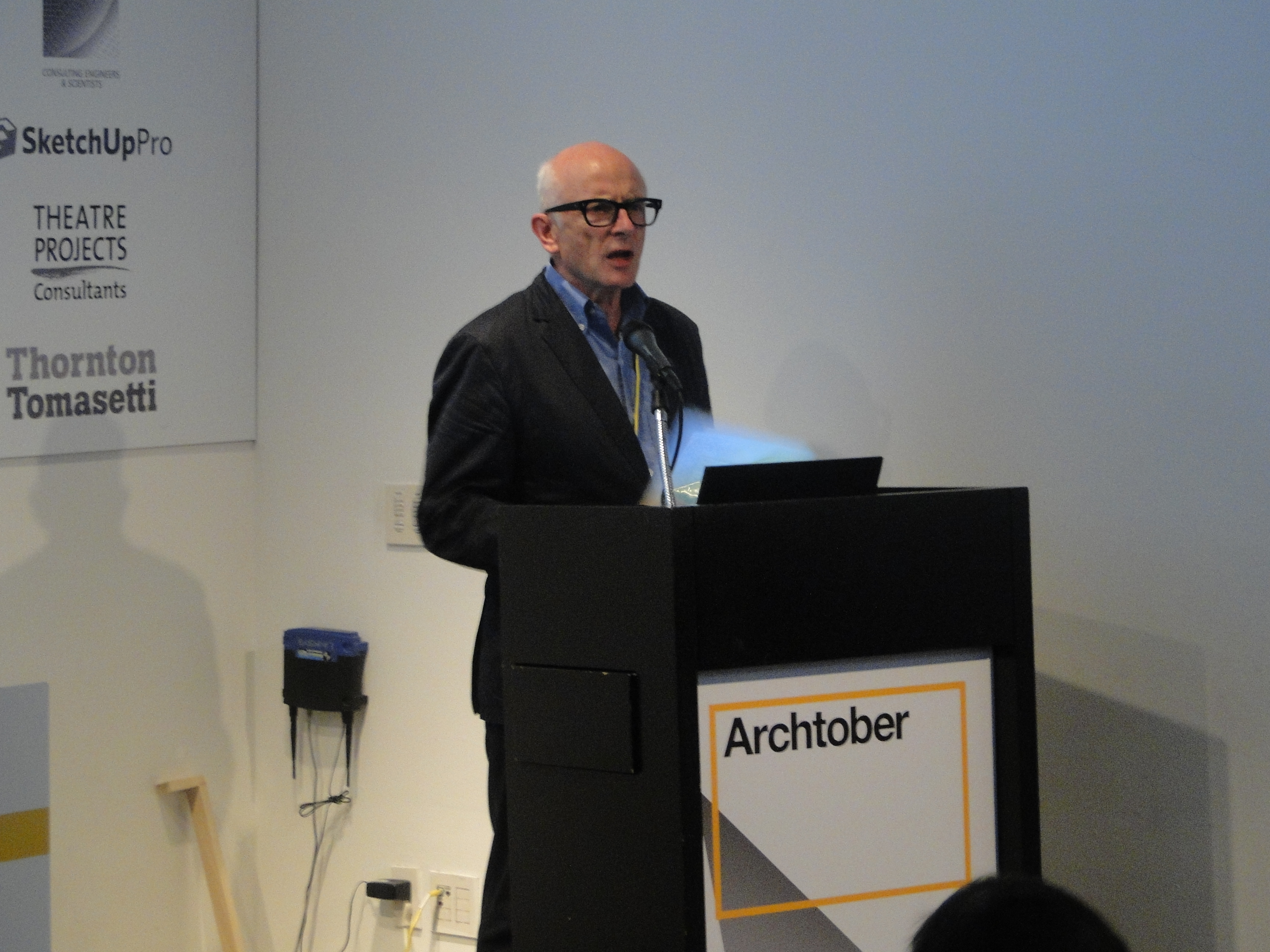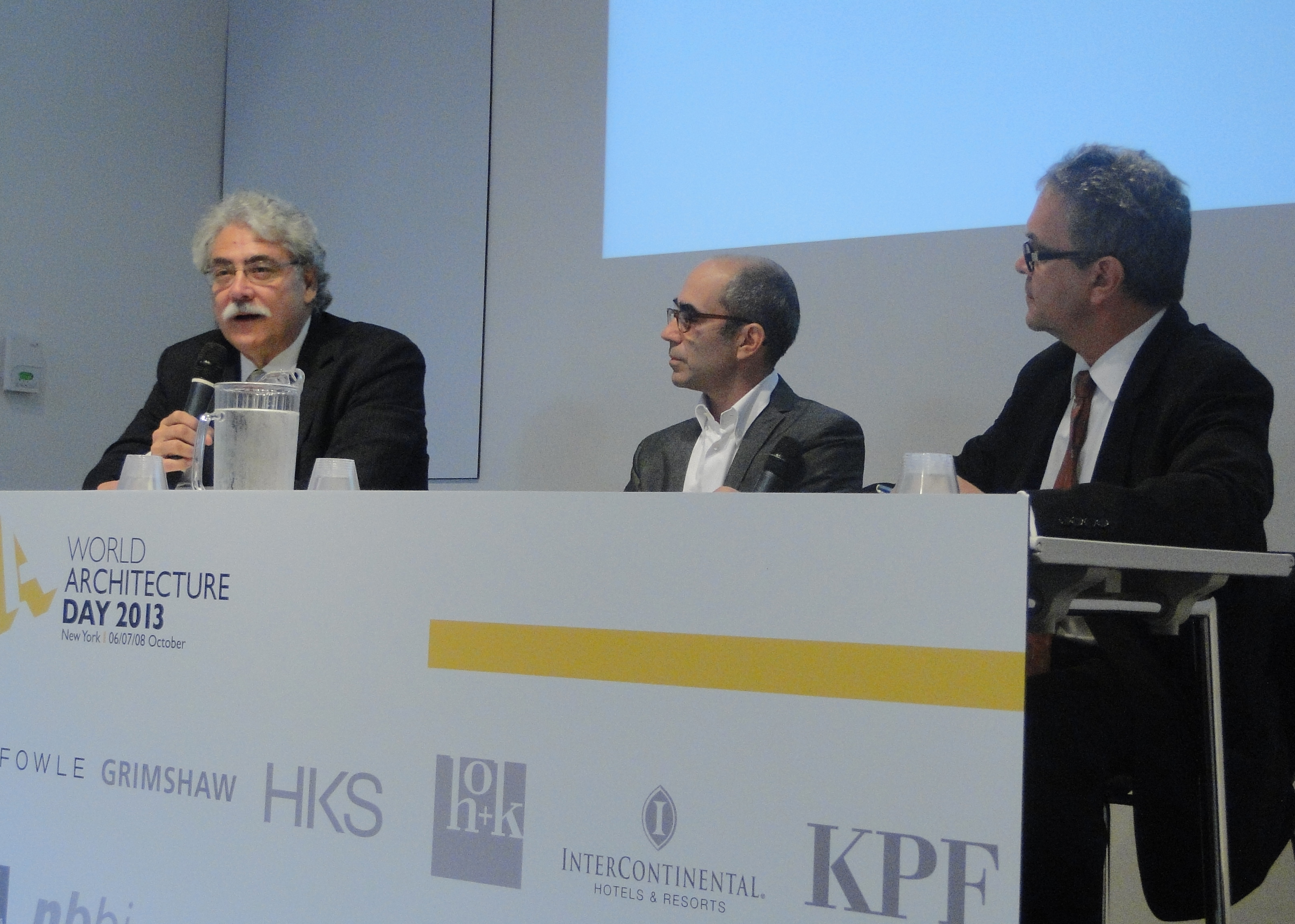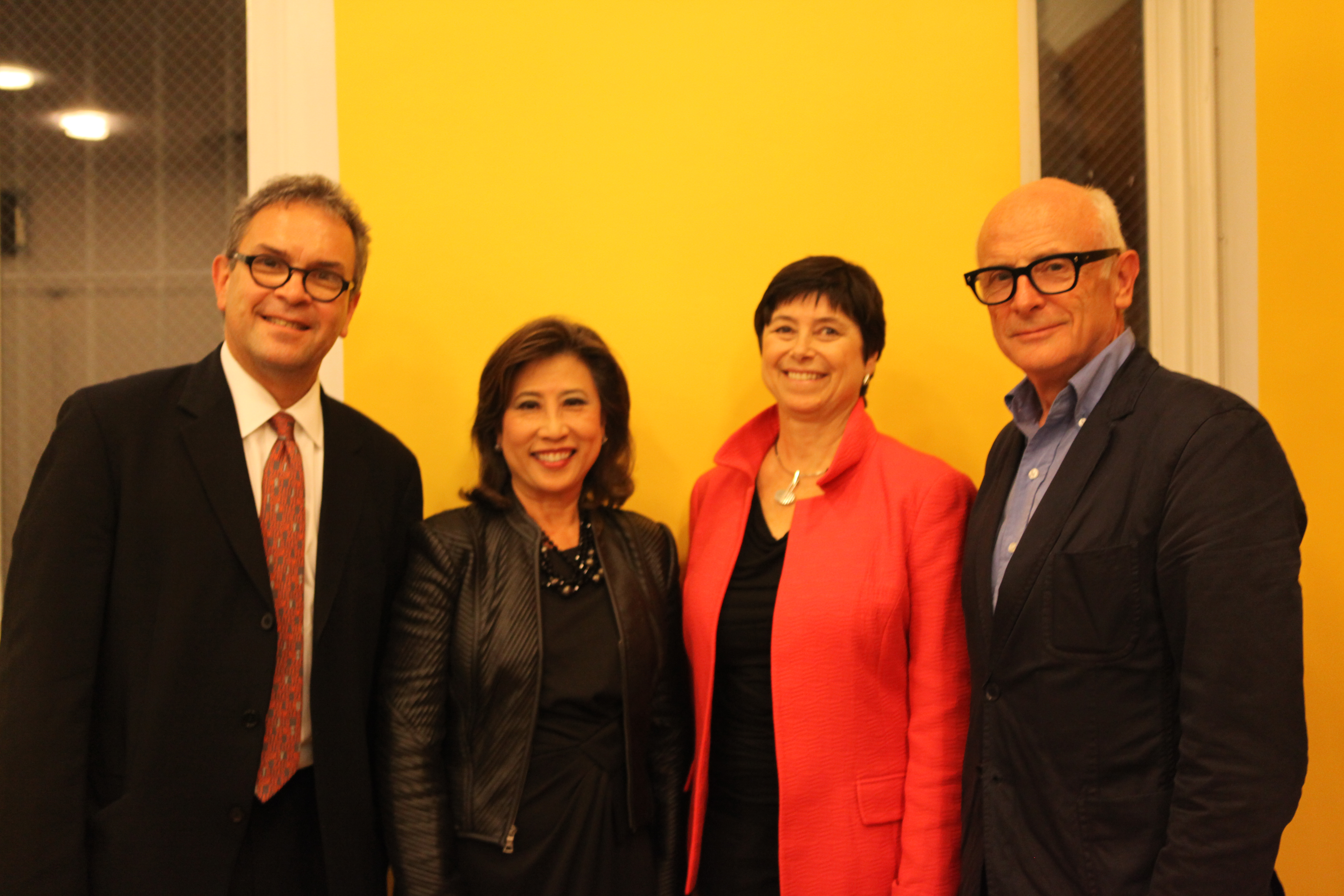by Camila Schaulson Frenz
During Archtober, New York City hosts a marathon of architecture and design conferences, from Architectural Record’s Innovation Conference, to the Association for Preservation Technology’s Preserving the Metropolis Annual Conference, and the Municpial Art Society’s MAS Summit for New York City. This year, the Center for Architecture joined in on conference frenzy, hosting World Architecture Day 2013 – Towards Eight Million: Housing the Next Generation on 10.07.13. Organized by World Architecture News, the conference was ensured international relevance in the architecture, planning, and design communities.
The conference serendipitously coincided with the tenth anniversary of the opening of the Center for Architecture on 10.07.03, allowing audiences and speakers alike to take a minute and think about the relevance of our own home. A panel discussion between AIANY Executive Director Rick Bell, FAIA, the Center’s architect Andrew Berman, AIA, and AIANY Past-President George Miller, FAIA, took a nostalgic look at the Center’s beginnings, while staying connected to the institution’s present and future. Miller, for example, mentioned an early exhibition Olympic Summer Game morphologies, curated by Meejin Yoon that featured the a 2012 Olympic bid proposal at Hudson Yards.
With 40 international speakers, the conference gathered leading experts from around the world to examine strategies to sustainably house the world’s growing population. AIANY 2013 President Jill N. Lerner, FAIA’s theme, “Global City / Global Practice,” which encourages architects to participate in dialogues across geopolitical boundaries, resonated in the opening remarks by Peter Murray, executive director of New London Architecture and Master of Ceremonies for the day, who spoke of cycling across America to learn lessons about active transportation. The strategies discussed at the conference ranged from specific bottom-up interventions in informal communities to technologically innovative solutions like modular skyscrapers, and future-thinking visions that rethink traditional ideas of housing.
L. Jay Cross, president of Related’s Hudson Yards, kicked off the housing discussion by painting a surprisingly bleak picture of real estate development’s inability to supply affordable housing. With more than 40 million square feet of new buildings, Hudson Yards will be doing its part to house some of the eight billion – but only those of a certain social demographic. Cross discussed “density’s price tag,” explaining how the need to build vertically results in extremely high square-footage costs that can only be justified via luxury housing.
One solution to the challenge laid out by Cross was explored during the “Pre-Fabricating Skyscrapers – the way forward…or fast track to failure?” panel. Moderator Antony Wood, executive director of the Council on Tall Buildings and Urban Habitats, referred to T30, a 30-story tower constructed in China in just 15 days, as a sign that something has fundamentally changed in the world of architecture. As Hani Rashid, co-founder of Asymptote, described “plug and play construction,” where pieces of infrastructure are updated, added, and removed, it was hard to shake the feeling that the future is here, making Plug-In City, Archigram’s imaginative project of the 1960s and ’70s, a reality.
However, the term “prefabricated” sets a bad tone, said Vishaan Chakrabarti, AIA, a partner at SHoP Architects. “It makes us think of prefab items as things made on the cheap, on the fly and shoddily put together, with no ability to inspire.” Eric Wittner, 3D Technology Evangelist at ESRI, spoke of the unique opportunities imparted by prefabrication, but also warned about its predisposition to generic design.
Fears of creating housing out of its regional context were assuaged by Erez Ella, founding director at HQ Architects, Lourenco Gimenes, Founding Director of FGMF, and Daniel Sundlin, a designer at Bjarke Ingels Group/BIG, in the panel “Regional Influences on Housing,” moderated by Chris Sullivan of C.C. Sullivan. Both Gimenes and Ella eschewed formal approaches to regionalism (a pointed arch need not mean Middle Eastern architecture) for spatial and sociopolitical approaches, respectively. Sundlin discussed the importance of global firms engaging with local communities to understand unique characteristics of place.
The program then proceeded to a discussion on affordable housing between David Farnsworhth, a principal at Arup; Michel Bertreux, partner at Tetrarc; Andrew Bernheimer, AIA, principal at Bernheimer Architecture and director of the Master of Architecture program at Parsons the New School for Design. The conference’s forward-looking view was evident, as moderator Sharon McHugh of World Architecture News asked panelists about the future of affordable housing. Bernheimer’s views were humbling, admitting that architects are trying to answer questions about housing markets, taxing policies, and planning regulations that they are not equipped to answer. Farnsworth echoed Cross’s keynote, stating that median incomes have stagnated as housing values have continued to rise due to construction methodology, and noting the possibilities inherent in modular designs. While Bertreux acknowledged the need to factor the market, codes, and regulations, he also expressed a belief in prioritizing people.
After a keynote presentation by Craig Dykers, AIA, founding partner of Snøhetta, which spanned from broad thoughts on the city to an intervention of benches in Guatemala City, attendees were treated to a panel titled “Slums: The Options,” where speakers discussed many similar, small-scale projects. Elisabete Franca, founding director of Studio2E-IdeiasUrbanas, stressed the strong social links found in informal settlements – where up to 20 families may share one credit card – which necessitate solutions that do not disrupt communities. Noting the disconnect between Dykers’ big-picture view and Franca’s small-scale interventions, Martha Throne, director of the IE School of Architecture and Design, expressed the need for a middle ground.
The World Architecture Day audience was transported from a conversation about on-the-ground informal settlement solutions to the open sea, with a discussion that bordered on the realm of science fiction. The panel “Building on Water,” with Koen Olthius, founder of Waterstudio, and Neeraj Bhatia, founder of Infranet Lab, was led by Brian Kikelly, CEO of World Cities Network. The conversation was preceded by a talk by Olthius, where he described the potential of floating buildings – not only to accommodate growing populations, but also to allow the creation of “scarless developments” that can be moved according to need. Floating hotels and stadiums, for example, could permit cities with fewer resources to host Olympic games. Bhatia discussed the construction of floating islands to house offshore oil rig workers, and wondered about the aesthetics of water-based urbanism. One couldn’t help but think of Kevin Costner’s soggy Waterworld.
As the pendulum swung back and forth – between small-scale, simple interventions to visions of the future that bordered on the fantastic – the conference finally came to a position of equilibrium during the panel on the Center for Architecture’s exhibition “Practical Utopias: Global Urbanism in Hong Kong, Seoul, Shanghai, Singapore, and Tokyo.” The title “Practical Utopias,” explained moderator and exhibition curator Jonathan D. Solomon, AIA, represents these buildings’ twin nature, at once utopian in their ambition to transform cities, and practical in their responses to the challenges of urbanization. The conversation managed to touch upon issues raised throughout the day. AIANY President Jill N. Lerner, FAIA, noted the political nature of discussions on housing. Mustafa Abadan, FAIA, design partner at Skidmore, Owings & Merrill, gave his thoughts on site-specific design, remarking that market forces are creating demands for spaces that are similar across the globe.
The conference ended with a presentation that perfectly melded “Practical Utopias,” a show that, Lerner admits, avoided housing projects due to the challenge of separating the topic from politics. Yarna Karim, of Studio Daniel Libeskind, discussed the firm’s recent work on residential projects, highlighting Reflections at Keppel Bay, featured in the exhibition. Those who are skeptical about the generic nature of residential towers need not fear: the six undulating towers create an experience where each level feels unique and offers inhabitants a different perspective. Libeskind’s project is no prefabricated replication, that’s for sure.
Event: World Architecture Day 2013
Location: Center for Architecture, 10.07.13
Speakers: Click here for a full list of speakers
Organizers: World Architecture News
Sponsors: BAU 2015, Duravit, Thornton Tomasetti, Akzo Nobel, Arup, Dow Corning, ESRI, Office for Visual Interaction, Quinette Gallay, Consulting Engineers & Scientists, SketchUp Pro, Theater Projects Consultants, Andre Kikoski Architect, Archtober, Asymptote Architecture, Auerbach Pollock Friedlander, Council on Tall Buildings and Urban Habitat, Consortium for Sustainable Urbanization, Dvida Health Bar, FXFOWLE, Grimshaw, HKS Design Studio, HOK, Intercontinental, KPF, L’Observatoire International, Michael Graves Design, NBBJ, Richard Meier & Partners Architects, SOM, Snøhetta, Studio Daniel Libeskind, The Standard, World Cities Network, C.C. Sullivan, e-architect, Elle Décor, Inhabitat, Luxury Properties, Architecture Expo Conference, Routledge



